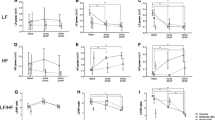Abstract
The goal of this study was to determine whether periodic breathing (PB), which is highly prevalent during sleep at high altitudes, imposes physiological penalties on the respiratory system in the absence of any accompanying disease. Using a computer model of respiratory gas exchange, we compared the effects of a variety of PB patterns on the chemical and mechanical costs of breathing to those resulting from regular tidal breathing. Although PB produced considerable fluctuation in arterial blood gas tensions, for the same cycle-averaged ventilation, higher arterial oxygen saturation and lower arterial carbon dioxide levels were achieved. This result can be explained by the fact that the combination of large breaths and apnea in PB leads to a substantial reduction in dead space ventilation. At the same time, the savings in mechanical cost achieved by the respiratory muscles during apnea partially offset the increase during the breathing phase. Consequently, the “pressure cost,” a criterion based on mean inspiratory pressure, was elevated only slightly, although the average work rate of breathing increased significantly. We found that, at extreme altitudes, PB patterns with clusters of 2 to 4 large breaths that alternate with apnea produce the highest arterial oxygenation levels and lowest pressure costs. The common occurrence of PB patterns with closely similar features has been reported in sleeping healthy sojourners at extreme altitudes. Taken together, these findings suggest that PB favors a reduction in the oxygen demands of the respiratory muscles and therefore may not be as detrimental as it is generally believed to be.
Similar content being viewed by others
References
Berssenbrugge, A.; Dempsey, J.; Iber, C.; Skatrud, J.; Wilson, P. Mechanisms of hypoxia-induced periodic breathing during sleep in humans. J. Physiol. 343:507–524; 1983.
Brusil, P.J.; Waggener, T.B.; Kronauer, R.E.; Gulesian, P. Methods for identifying respiratory oscillations disclose altitude effects. J. Appl. Physiol. 48:545–556; 1980.
Cotes, J.E. Ventilatory capacity at altitude and its relation to mask design. Proc. R. Soc. Lond. [Biol.] 143:32–39; 1954.
D'Angelo, E.; Calderini, E.; Torri, G.; Robatto, F.M.; Bono, D.; Milic-Emili, J. Respiratory mechanics in anesthetized paralyzed humans: Effects of flow, volume, and time. J. Appl. Physiol. 67:2556–2564; 1989.
Grodins, F.S.; Buell, J.; Bart, A.J. Mathematical analysis and digital simulation of the respiratory control system. J. Appl. Physiol. 22:260–267; 1967.
Khoo, M.C.K. Periodic breathing. In: Crystal, R.G.; West, J.B.; Barnes, P.J.; Cherniack, N.S.; Weibel, E.R. (eds.) The lung: Scientific foundations. New York: Plenum Press; 1991: pp. 1419–1431.
Khoo, M.C.K. The noninvasive estimation of cardiopulmonary parameters. Boston, MA: Harvard University; 1981. Ph.D. Dissertation.
Kronauer, R.E.; Brusil, P.J. Periodic breathing can reduce required muscular effort. Physiologist 21:68; 1978. Abstract.
Lahiri, S.; Maret, K.; Sherpa, M.G. Dependence of high altitude sleep apnea on ventilatory sensitivity to hypoxia. Respir. Physiol. 52:281–301; 1983.
Lange, R.L.; Horgan, J.D.; Botticelli, J.T.; Tsagaris, T.; Carlisle, R.F.; Kuida, H. Pulmonary to arterial circulatory transfer function: Importance in respiratory control. J. Appl. Physiol. 21:1281–1291; 1966.
McGregor, M.; Becklake, M. The relationship of oxygen cost of breathing to respiratory mechanical work and respiratory force. J. Clin. Invest. 40:971–980; 1961.
Mead, J. Control of respiratory frequency. J. Appl. Physiol. 15:325–336; 1960.
Milic-Emili, J. Work of breathing. In Crystal, R.G.; West, J.B. (eds.) The lung: Scientific foundations. New York: Raven Press, 1991: pp. 1065–1075.
Olszowka, A.J.; Rahn, H.; Farhi, L.E. Blood gases: Hemoglobin, base excess and maldistribution. Philadelphia: Lea and Febiger; 1973.
Otis, A.B.; Fenn, W.O.; Rahn, H. Mechanics of breathing in man. J. Appl. Physiol. 2:592–607; 1950.
Poon, C.-S. Ventilatory control in hypercapnia and exercise: Optimization hypothesis. J. Appl. Physiol. 62:2447–2459; 1987.
Reite, M.; Jackson, D.; Cahoon, R.L.; Weil, J.V. Sleep physiology at high altitude. Electroenceph. Clin. Neurophysiol. 32:701–705; 1972.
West, J.B.; Peters, Jr., R.M.; Aksnes, G.; Maret, K.L.; Milledge, J.S.; Schoene, R.B. Nocturnal periodic breathing at altitudes of 6,300 and 8,050 m. J. Appl. Physiol. 61:280–287; 1986.
White, D.P.; Gleeson, K.; Pickett, C.K.; Rannels, A.M.; Cymerman, A.; Weil, J.V. Altitude acclimatization: Influence on periodic breathing and chemoresponsiveness during sleep. J. Appl. Physiol. 63:401–412; 1987.
Yamashiro, S.M.; Grodins, F.S. Optimal regulation of respiratory airflow. J. Appl. Physiol. 30:597–602; 1972.
Author information
Authors and Affiliations
Rights and permissions
About this article
Cite this article
Ghazanshahi, S.D., Khoo, M.C.K. Optimal ventilatory patterns in periodic breathing. Ann Biomed Eng 21, 517–530 (1993). https://doi.org/10.1007/BF02584334
Issue Date:
DOI: https://doi.org/10.1007/BF02584334




